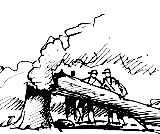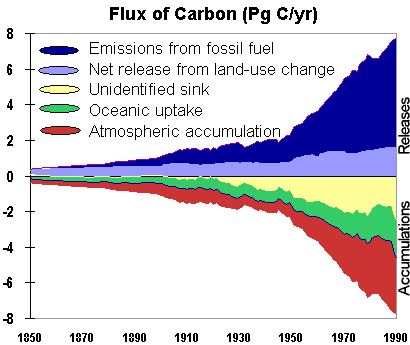 |
 |
 In the last few years
several independent analyses based on geochemical data (data from the atmosphere
and oceans) and a series of carbon budgets based on data from forest inventories
have shown that carbon is accumulating in terrestrial ecosystems, although
estimates of the magnitude and location of the accumulation vary among the
analyses. Direct evidence for an uptake of carbon from measurements on the
ground (forest inventories) is only available from countries of the northern
mid-latitudes, and a similar but unmeasured uptake may also be occurring in the
tropics, where forest inventories are rarely carried out. In the last few years
several independent analyses based on geochemical data (data from the atmosphere
and oceans) and a series of carbon budgets based on data from forest inventories
have shown that carbon is accumulating in terrestrial ecosystems, although
estimates of the magnitude and location of the accumulation vary among the
analyses. Direct evidence for an uptake of carbon from measurements on the
ground (forest inventories) is only available from countries of the northern
mid-latitudes, and a similar but unmeasured uptake may also be occurring in the
tropics, where forest inventories are rarely carried out.
 Two
approaches have been used to calculate changes in terrestrial carbon storage
with data obtained from terrestrial ecosystems, rather than with atmospheric or
oceanographic data. One approach is based on the changes in carbon that result
from changes in land use (conversion of forest to agricultural land, abandonment
of agricultural land, harvest and regrowth). This is the approach we use at the
Center. The other approach uses measurements of forest biomass obtained through
forests inventories to determine change directly. Two
approaches have been used to calculate changes in terrestrial carbon storage
with data obtained from terrestrial ecosystems, rather than with atmospheric or
oceanographic data. One approach is based on the changes in carbon that result
from changes in land use (conversion of forest to agricultural land, abandonment
of agricultural land, harvest and regrowth). This is the approach we use at the
Center. The other approach uses measurements of forest biomass obtained through
forests inventories to determine change directly.
 These
latter studies may also calculate changes in the amount of carbon stored in wood
products and soil, but in this respect the two approaches are similar. If a
significant fraction of the missing carbon sink is to be found in mid-latitude
forests, one would expect direct measurement of biomass to show greater
accumulations of carbon than analyses in which calculated accumulations result
only from regrowth following previous harvests or abandonment of agricultural
land. Data from Canada, the conterminous U.S., Europe, and the former U.S.S.R.
show this is indeed the case. Accumulations of carbon in biomass and soil are
0.5-0.8 PgC/yr greater than expected from past management practices (land-use
change). These
latter studies may also calculate changes in the amount of carbon stored in wood
products and soil, but in this respect the two approaches are similar. If a
significant fraction of the missing carbon sink is to be found in mid-latitude
forests, one would expect direct measurement of biomass to show greater
accumulations of carbon than analyses in which calculated accumulations result
only from regrowth following previous harvests or abandonment of agricultural
land. Data from Canada, the conterminous U.S., Europe, and the former U.S.S.R.
show this is indeed the case. Accumulations of carbon in biomass and soil are
0.5-0.8 PgC/yr greater than expected from past management practices (land-use
change).
 In the
tropics (where forest inventories are rare), the total net flux of carbon from
changes in land use (1.6 PgC/yr) is consistent with recent estimates of flux
based on atmospheric data, but the geographic distribution of the flux is not
the same. In the
tropics (where forest inventories are rare), the total net flux of carbon from
changes in land use (1.6 PgC/yr) is consistent with recent estimates of flux
based on atmospheric data, but the geographic distribution of the flux is not
the same.
 Globally,
terrestrial ecosystems are calculated to have been a net source of 1.0 to 1.3
PgC/yr to the atmosphere during the 1980s. For the period 1850 to 1990, a
geochemical summary of the global carbon cycle is as follows (the terrestrial
term having been determined indirectly by difference) (units are PgC): Globally,
terrestrial ecosystems are calculated to have been a net source of 1.0 to 1.3
PgC/yr to the atmosphere during the 1980s. For the period 1850 to 1990, a
geochemical summary of the global carbon cycle is as follows (the terrestrial
term having been determined indirectly by difference) (units are PgC):
|






